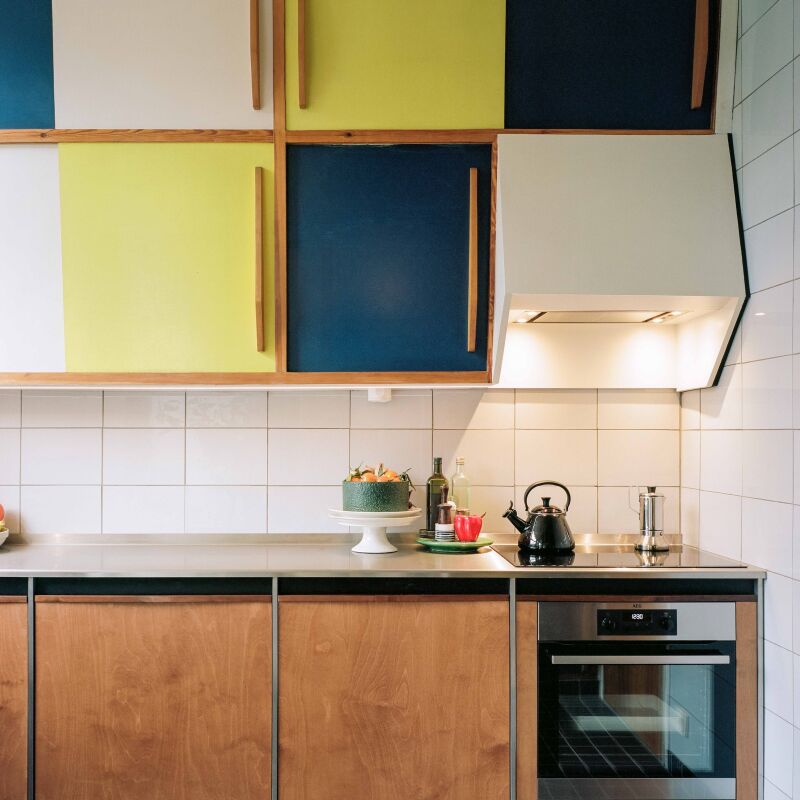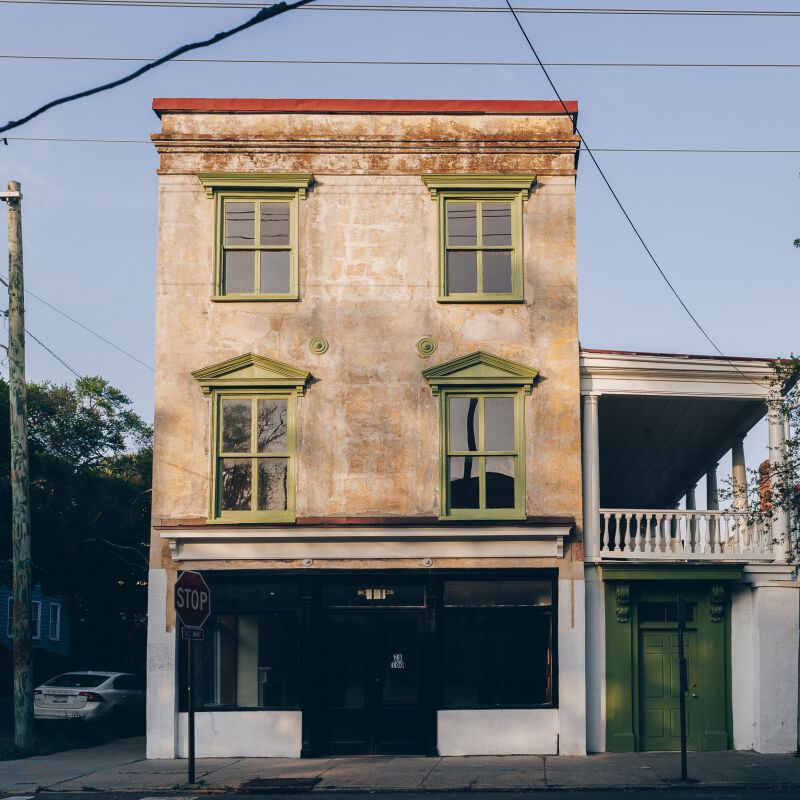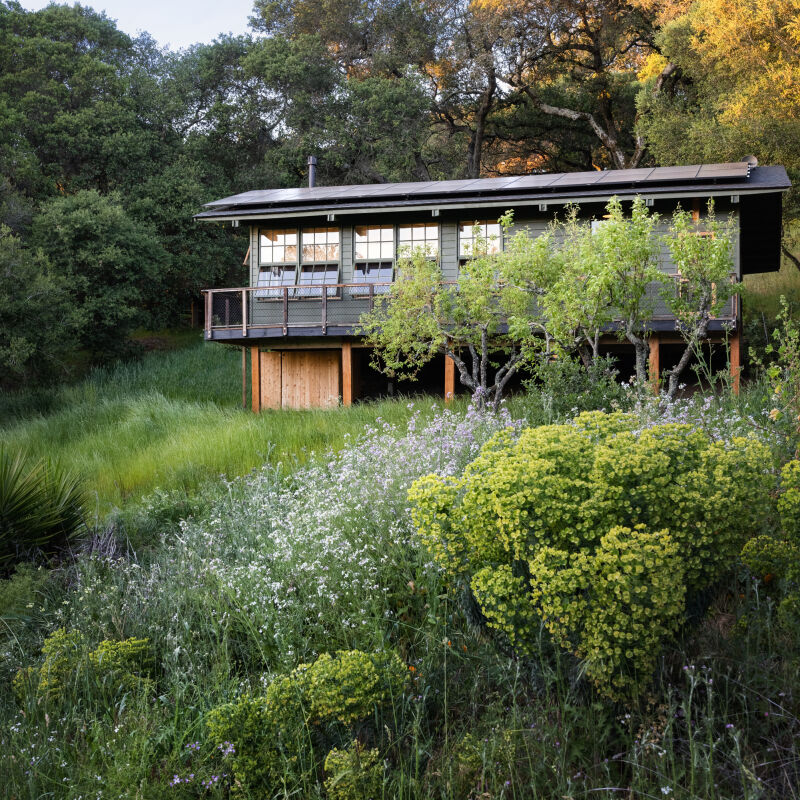We discovered interior designer Carmella Rayone McCafferty via her 13-foot-wide kitchen with ingenious faux soapstone counters and a place for everything. On her blog Assortment, Carmella chronicles life for her family of five in their 665-square-foot cabin in Wyoming, and writes about “living smaller in order to live larger.”
After looking inside her clockwork cupboards–and hearing about how she and her husband, Russ, a pilot, and their sons, who are 11, 13, and 15 and homeschooled, happily coexist in a two-bedroom, one-bathroom house–we asked her to fill us in on how to achieve the clutter-free life. Carmella stresses that she’s not a minimalist: “What we do is live simply, because we’ve discovered we’re able to enjoy the good things in life more when we own less.” Here’s her deprivation-free approach.
Photography by Carmella Rayone McCafferty via Assortment, unless otherwise noted.

Above: If only all campers were this pretty. After selling their four-bedroom house in Florida in 2013, Carmella and clan moved to a rental in Wyoming and then spent seven months in a camper while their cabin was being built. “Camper living gave us a sense of how small we could go and still be comfortable,” she says. “There’s something profound about being set in a place that forces you to define so carefully who you are and what you actually need to fully live.” Photograph of a restored 1954 Airstream Flying Cloud Travel Trailer via HomeDSGN.
Step 1: Envision your essentials by packing for a two-week trip in a camper.
“People think they have to give it all up and have one spoon and one fork to achieve the simpler life. In truth, what you need to do is figure out what’s important to you. A good way to begin is to actually pack up your family–or create packing lists–for what you’d need to live in a camper. Start by defining the basics: plates, bowls, cups, clothes, towels, beds, lamps, soap, toothbrushes. Then widen the circle of inclusion by adding the things each of you really want, the extras that make your life sing: favorite books, games, hobby supplies, art, rugs, pillows. But select these items being mindful of a lack of space. What really matters to you will start to become clear.”
Not into roughing it? Here’s another exercise Carmella recommends: “Imagine that you have to leave your house forever with only a moment’s notice–what would you take with you? Imagine that you have three hours’ notice–now, what would you take? Imagine that you have one day’s notice–which of your things would make the cut? This is a bit extreme, and I hope it won’t become a real-life scenario for any of us, but it brings out definite answers where once there were question marks.”

Above: The McCafferty’s 665-square-foot cabin was custom-built to Carmella’s exacting specs. An avid cook and baker, she inventoried all of her kitchen essentials, jettisoned the excess (allowing in a few extras, including three different rolling pins), and then designed a place for everything. Explore all the details and check out her ingenious over-the-fridge baking pan storage in our post A Low-Cost Cabin Kitchen for Five.
Step 2: Go room by room and weed out the nonessentials.
After envisioning small-space living and what would make the cut, get down to work in each part of your house. Carmella notes that the kitchen, bathroom, bedroom, and wardrobe are what require forensic treatment. Here’s her solution for each.
Kitchen: “Make a list of the things you know you need based on how you cook. You’ll discover, as I did, that you own an amazing amount of unnecessary items. Keep a few meaningful extras (I have a weakness for rolling pins) and give the rest away. I used to have two sets of plates and flatware; now I have one. I decided to go for all-white dishes that I love and that always look beautiful. They can be layered with vintage salad plates–but you don’t need to keep grandma’s 20 place-setting china; hold on to just the salad plates or a few settings. How many mugs does a family of five need? I decided eight, all white. I also have one set of nesting bowls, three covered baking dishes, three pots and three pans in different sizes, one each of the basic cooking tools (like spatulas and slotted spoons)–and not much more.” The family’s cloth napkins are stowed in a basket–Carmella had an artist on Etsy monogram metal rings for each family member so napkins can be used until they’re dirty and get swapped out. She has room on her shelves for one more platter and is on the lookout for an amazing cutting board: “I’d swap my Homegoods cutting board for it. You have to weigh things out: Think quality over quantity.”
Bathroom: Are too many dirty towels keeping you from clarity? Carmella’s family has only one bath towel per person (“I wash them each week and back they go. Guests get a towel and facecloth hung on a heavy wire hanger, a movable towel rod of sorts that fits right on the curtain rod.”) For drying hands, she keep two hand towels: one hangs in the bathroom and gets replaced midweek. As for toiletries, there’s a cabinet that holds the essentials–toothbrushes, toothpaste, extra rolls of TP, Band-Aids, painkillers, and an extra bar of soap. “We don’t keep extras; when our bottle of shampoo is emptyish, I buy another.”
Bedroom: How many sets of sheets does a person need? One set per bed does the trick for Carmella–and no linen closet. “I have extra pillowcases tucked in between the mattresses–they’re our travel pillowcases, because I don’t like my white pillowcases going out into the world.” She keeps an extra set of sheets for guests–”the sleeper sofa in the living room always has fresh bedding on it.” And she keeps a spare quilt in a suitcase in the master bedroom for when one of her kids wants to sleep on the floor or build forts. (Bedrooms, according to Carmella, needn’t only contain a bed: Take a look at the photos below to see what else she incorporates.)
Wardrobe: What do most people have the most of? “Clothes are the first thing that comes to mind,” says Carmella. “I used to work in fashion as a buyer, so I’ve seen how much people accumulate. I went from a walk-in closet to 16 inches of hanging rod space and some drawers.” To whittle down what you need, pack for that two-week trip, she advises: “Think about it–you always pack your favorites. That’s my total wardrobe.” As for her husband: “He keeps a minimal wardrobe on his own; his junk drawer is a single cigar box.” And for her boys, who share a room, each has four wooden apple crates for clothes that they stow under their beds plus a shared wardrobe closet. Each boy also has a “fun pack”–a catchall crate for squirreling away whatever they like.

Above: Carmella devised a knife rack at the back of the stove. And since there’s space, she allowed herself to exceed what she considers the three essentials: a chef’s knife, paring knife, and bread knife.
Step 3: Create a place for everything (and make it easy to reach).
If you haven’t already detected, Carmella is a staunch believer in creating order via storage. Her cabin is replete with clever built-ins, and she knows where everything belongs, down to the pinecones and fossils gathered on family outings (living room shelf and budding geologist son’s “fun pack,” respectively). “With kids, the key is to make storage accessible and easy. We have one basket for all the trains and one basket for the Legos. I don’t label; I just keep things easy and within reach.”
For parents with young kids, she advises “Only have a few toys available at one time; rotate them out. It helps so much with clutter and it keeps kids interested.”

Above: There’s room for sentimental objects on Carmella’s orderly living room shelves. The curtained low half conceals pantry goods.
Step 4: Stow the overflow in a designated (and orderly) dumping ground.
Whether it’s basement shelves, a pantry, or, in Carmella’s case, a shed, it helps enormously to have a place to exile the overflow. The shed that stands outside the family’s cabin holds, among other things, big boxes for the boys’ sports equipment, a giant bag of flour, a potting bench and work bench, the family’s camping, fishing, and ski equipment, and beach towels rolled up in a tote bag. In the center, a pair of bookcases hold the boys’ schoolbooks, so, they too don’t start piling up. Also in the shed: a box or two of items classified as “Stay or Go?”: “Over time the answer for each becomes clear: If you haven’t gone rooting for these things, chances are you don’t need them.”

Above: In the compact master bedroom, his and hers narrow closets take the place of bedside tables. The round mirror makes the space seem larger.

Above L: The cupboards have built-in storage niches. Above R: Carmella’s desk, aka the One-Drawer Wonder was found at the Salvation Army for $1; it fits perfectly between the two wardrobes, one of which hides a stacked washer/dryer and the other Carmella’s sewing machine.

Above: A view of the sleeping loft that the three sons share. Each has a curtained-off bed and work area (the drafting table belongs to the son who likes to draw).

Above: Carmella put the slim space above the boys’ closet to use as an electronic console storage niche for the shared computer, PS3, and DVR, as well as the router and modem.
Step 5: Always, always clean up before moving on to your next activity.
How is it possible to keep the mess from creeping in? And for five people to find breathing room in so little space? Carmella’s cardinal rule is that things must be put away at the end of every activity. And because there’s an easy-to-reach place for everything, that almost always happens. True, the boys’ football helmets often land under their beds, but little else falls outside the designated lines.

Above L: For the lone bathroom, Carmella chose a pedestal sink “for the classic style as well as the visual room it affords.” Above R: “We’ve found that using hooks instead of towel bars is a great trick for saving space and for making it easier for the boys to hang their towels (this worked especially well when they were little and towel bars would have been impossible for them).
Step 6: Whenever new goods come in, give some old goods the boot.
Ready for a new pair of jeans? If they’re better than what you’ve got, bring them in and give away a pair. Apply this rule to everything. And make your purchases mindfully: “When there’s a need to buy something, we buy with quality in mind. I often research what’s available, single out the best version, and then see if I can find it on eBay or Craigslist. I’ve done this with everything from clothes to light fixtures. It’s a great way to reuse and support the seller if you don’t have the means or desire to pay retail.”

Above L and R: In the entry, a bentwood coatrack holds Carmella’s purse (where she always keeps her keys in the outside pocket) and her husband’s hats. The other hooks stand ready for guests; the family’s own coats and shoes are stored in parents’ and kids’ closets, each of which have custom metal boot trays that “fit the closets perfectly and keep mud and snow contained.” The stair leads to the boys’ bunk.
Step 7: Live by the William Morris edict: “Have nothing in your house that you don’t know to be useful or believe to be beautiful.”
“A lifestyle of simplicity is ongoing,” says Carmella. “We have a perpetual donation box to contain the skimmings of life that need to go. Above all, be mindful of what you bring through your door: Is it useful? Is it beautiful? Do you really need it?”
Read more of Carmella’s wisdom and tour each of the rooms in her house at Assortment. Intrigued by cabin living? See the first in a series of cabin plans that she’s been working on and learn about them here.
For more tips on living mindfully, go to:
- Expert Advice: 10 Ways to Live with Less from Zero Waste Home
- Garbage-Free Living: The Zero-Waste Challenge
- 10 Secrets for Happy Housekeeping
- Survival Guide: Life in a Tiny Apartment
Frequently asked questions
Who is Carmella Rayone?
Carmella Rayone is the creator of Assortment, a home decor and lifestyle blog. She is also the author of The Assorted Table, a cookbook featuring recipes and entertaining tips.
What is the no-cost remodel?
The no-cost remodel is Carmella Rayone's 7-step plan to declutter your home and create a more organized and functional living space without spending any money.
What are the seven steps of the no-cost remodel?
The seven steps of the no-cost remodel are: 1. Identify your clutter zones. 2. Use what you have. 3. Focus on functionality. 4. Shop your home. 5. Declutter and donate. 6. Create storage solutions. 7. Maintain your clutter-free space.
How can I identify my clutter zones?
To identify your clutter zones, walk through your home and take note of areas that are consistently messy or disorganized. Common clutter zones include entryways, countertops, closets, and storage areas.
What does it mean to 'shop your home'?
To 'shop your home' means to look for unused or underutilized items in your home that can be repurposed to solve a storage or organization problem. For example, using a basket as a catch-all for mail or keys.
How can I maintain a clutter-free space?
To maintain a clutter-free space, make a habit of decluttering regularly and staying organized. This can include daily tidying, frequent deep cleans, and setting aside a specific time for decluttering, such as once a month.






Have a Question or Comment About This Post?
Join the conversation